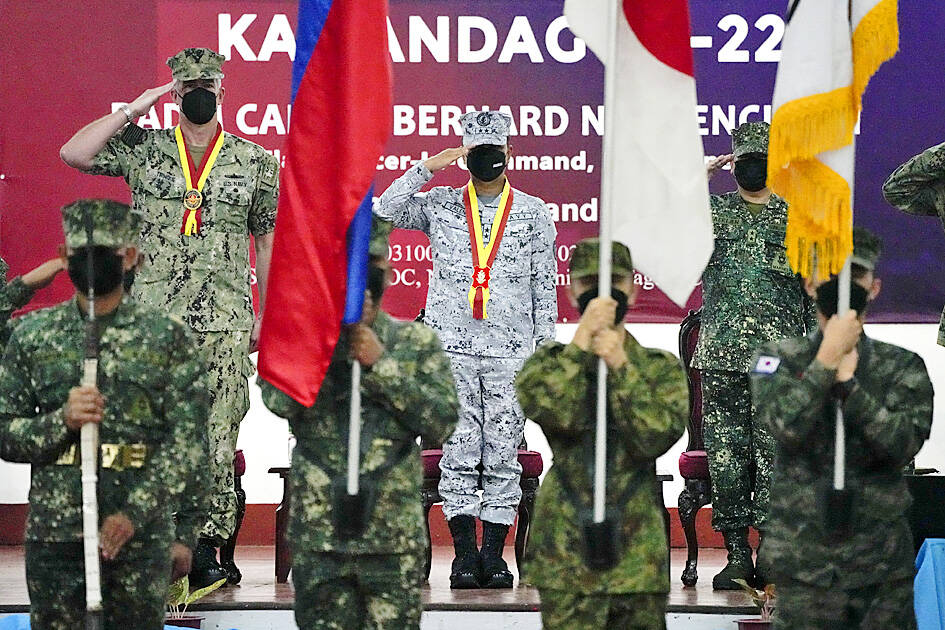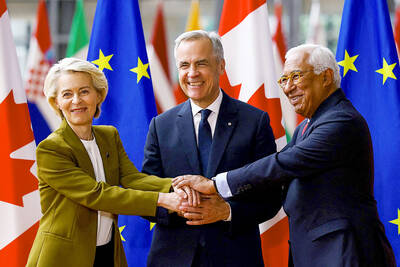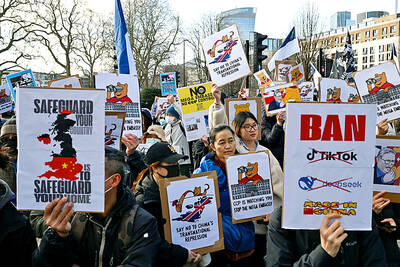More than 2,500 US and Philippine marines yesterday joined combat exercises to be able to respond to any sudden crisis in a region long on tenterhooks over South China Sea territorial disputes and increasing tensions over Taiwan.
The annual military drills are some of the largest so far between the longtime treaty allies under newly elected Philippine President Ferdinand Marcos Jr. His predecessor, Rodrigo Duterte, had been an outspoken critic of US security policies and frowned on military exercises with US forces he said could offend China.
Called Kamandag, the Tagalog acronym for “Cooperation of the Warriors of the Sea” — the drills involve 1,900 US Marines and more than 600 mostly Philippine counterparts in mock amphibious assaults and special operations, US and Philippine military officials said.

Photo: AP
The US’ HIMARS missile launchers and supersonic fighter jets would be in live-fire maneuvers that are to end on Friday next week, they said.
The venues include the western island province of Palawan, which faces the South China Sea, and the northern Philippines, across the Luzon Strait from Taiwan.
The military maneuvers in the Philippines are being held simultaneously with combat exercises between US Marines and Japan Self-Defense Forces on Japan’s northern island of Hokkaido that involve about 3,000 military personnel from both sides, US military officials said.
US Major General Jay Bargeron of the Japan-based 3rd Marine Division said the simultaneous exercises were aimed at bolstering the defensive capabilities of the US alliances with the Philippines and Japan “through realistic combined training.”
“These exercises will allow our forces to strengthen interoperability and readiness to ensure we are prepared to rapidly respond to crisis throughout the Indo-Pacific,” Bargeron said in a statement.
“Our strength, resolve and commitment to our allies and partners in the region are our most effective deterrent,” US Marine Lieutenant Colonel Kurt Stahl told reporters. “Together, we can deter potential adversaries from ever testing our capabilities or our relationships.”
In July, US Secretary of State Antony Blinken called on China to comply with a 2016 arbitration ruling that invalidated Beijing’s vast territorial claims in the South China Sea and warned that Washington is obligated to defend the Philippines under the 1951 US-Philippines Mutual Defense Treaty if Philippine forces, vessels or aircraft come under attack in the disputed waters.
The ruling was issued by an arbitration tribunal set up in The Hague under the UN Convention on the Law of the Sea after the Philippine government complained in 2013 about China’s seizure of a shoal off its northwestern coast.
China did not participate, called the arbitration decision a sham and continues to defy it.
In addition to China and the Philippines, Taiwan, Vietnam, Malaysia and Brunei have had overlapping claims in the busy waterway, where an estimated US$5 trillion in goods passes each year, and which is believed to be rich in undersea gas and oil deposits.
Separately, US President Joe Biden last month said that US forces would defend Taiwan if Beijing tries to invade the nation.

The team behind the long-awaited Vera Rubin Observatory in Chile yesterday published their first images, revealing breathtaking views of star-forming regions as well as distant galaxies. More than two decades in the making, the giant US-funded telescope sits perched at the summit of Cerro Pachon in central Chile, where dark skies and dry air provide ideal conditions for observing the cosmos. One of the debut images is a composite of 678 exposures taken over just seven hours, capturing the Trifid Nebula and the Lagoon Nebula — both several thousand light-years from Earth — glowing in vivid pinks against orange-red backdrops. The new image

Canada and the EU on Monday signed a defense and security pact as the transatlantic partners seek to better confront Russia, with worries over Washington’s reliability under US President Donald Trump. The deal was announced after a summit in Brussels between Canadian Prime Minister Mark Carney and European Commission President Ursula von der Leyen and European Council President Antonio Costa. “While NATO remains the cornerstone of our collective defense, this partnership will allow us to strengthen our preparedness ... to invest more and to invest smarter,” Costa told a news conference. “It opens new opportunities for companies on both sides of the

ESPIONAGE: The British government’s decision on the proposed embassy hinges on the security of underground data cables, a former diplomat has said A US intervention over China’s proposed new embassy in London has thrown a potential resolution “up in the air,” campaigners have said, amid concerns over the site’s proximity to a sensitive hub of critical communication cables. The furor over a new “super-embassy” on the edge of London’s financial district was reignited last week when the White House said it was “deeply concerned” over potential Chinese access to “the sensitive communications of one of our closest allies.” The Dutch parliament has also raised concerns about Beijing’s ideal location of Royal Mint Court, on the edge of the City of London, which has so

OVERHAUL: The move would likely mark the end to Voice of America, which was founded in 1942 to counter Nazi propaganda and operated in nearly 50 languages The parent agency of Voice of America (VOA) on Friday said it had issued termination notices to more than 639 more staff, completing an 85 percent decrease in personnel since March and effectively spelling the end of a broadcasting network founded to counter Nazi propaganda. US Agency for Global Media (USAGM) senior advisor Kari Lake said the staff reduction meant 1,400 positions had been eliminated as part of US President Donald Trump’s agenda to cut staffing at the agency to a statutory minimum. “Reduction in Force Termination Notices were sent to 639 employees at USAGM and Voice of America, part of a